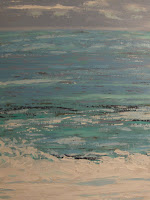
Today’s Image
The last few Orbisplanis blogs were about painting from reference photos, so I wanted to show you one of my acrylics that I completed late last month ( October, 2008). I mentioned this acrylic a few blogs ago, but had not posted it. I painted it from a reference photo I found online at a travel website if I recall. It’s of the surf somewhere in the Caribbean and to repeat, my palette was: Reeves Cerulean Blue, Amsterdam Sky Blue Light, Van Gogh Greyish Blue, Fundamentals Cadmium Blue Green Light Hue, Liquitex Basics Light Aqua Green, Grumbacher Payne’s Gray, and Winsor & Newton Galeria Titanium White as my palette. I used the same process I discussed in the last blog except that I was not the photographer. Anyway I wanted to post it for you, and it’s Today’s Image.
Color Palettes
If you read art books or take art classes or just like to experiment with color mixing, you’ve probably thought about your paint color palette, or maybe you haven’t. If you’re an artist who believes that ‘anything goes’ when it comes to art; that is, art is in the eye of the beholder, then you may not have a palette at all. If every canvas is a new beginning, then you may not think of a palette except in the context of your immediate artwork.
But I’m getting ahead of myself. I looked up a definition of color palette and will share these two.
One is one from Answer.com that is very traditional: a board, typically with a hole for the thumb, which an artist can hold while painting and on which colors are mixed; the range of colors used in a particular painting or by a particular artist, also known as a limited palette.
In the digital age, it can be much different, so here’s the other from PC Magazine: also called a "color lookup table," "lookup table," "index map," "color table" or "color map," it is a commonly used method for saving file space when creating 8-bit color images. Instead of each pixel containing its own red, green and blue values, which would require 24 bits, each pixel holds an 8-bit value, which is an index number into the color palette. The color palette contains 256 predefined RGB values from 0 to 255.
I Googled ‘color palette’ and received 2,370,000 hits—can there really be that much information on color palettes? Apparently so. And there’s a whole range of discussion on the subject.
I found this basic discussion on About.com, which gets back to basics by asking, “what colors do you need to start painting with acrylics?” It then gives you nine colors to start with and a primer on why each one is good: cadmium red medium, pthalo blue, cadmium yellow medium, titanium white, mars black, burnt umber, pthalo green, orange, and purple. I am not advocating this palette at all, but just wanted to give you what someone (an artist, I presume) thinks you should start with.
At the other end of the spectrum (no pun intended) is the digital side of color palettes. As I said, I found 2,730,000 hits when I Googled ‘color palette.’ The no.1 hit is Color Palette Generator and when you click on it, you enter the world of digital color palettes, used more often than not, by professional graphic designers for on-screen visual effects and websites.
The site is DeGraeve.com and on the site if you click About, it says: “DeGraeve.com has focused on developing tools to solve specific "problems." Sometimes that problem is generating an ASCII art version of your face. Other times the problem involves divining a color palette from an image or making your own business cards.” What?
What I found it to be (and you may be interested, as I was, to play around with it) is a tool that allows you to select an image, and the Color Generator will provide the digital color palette of the image. Cool. Try it, and appatrently there are a lot of other color generator tools out there, too.
While this tool is for digital palettes, I found it helpful for regular old ‘analog’ colors (and regular artists) in that you can eyeball-match these colors and attempt to mix them using the basic palette provided on About.com or other basic color palettes as well.
In the Studio
Cheers!
No comments:
Post a Comment